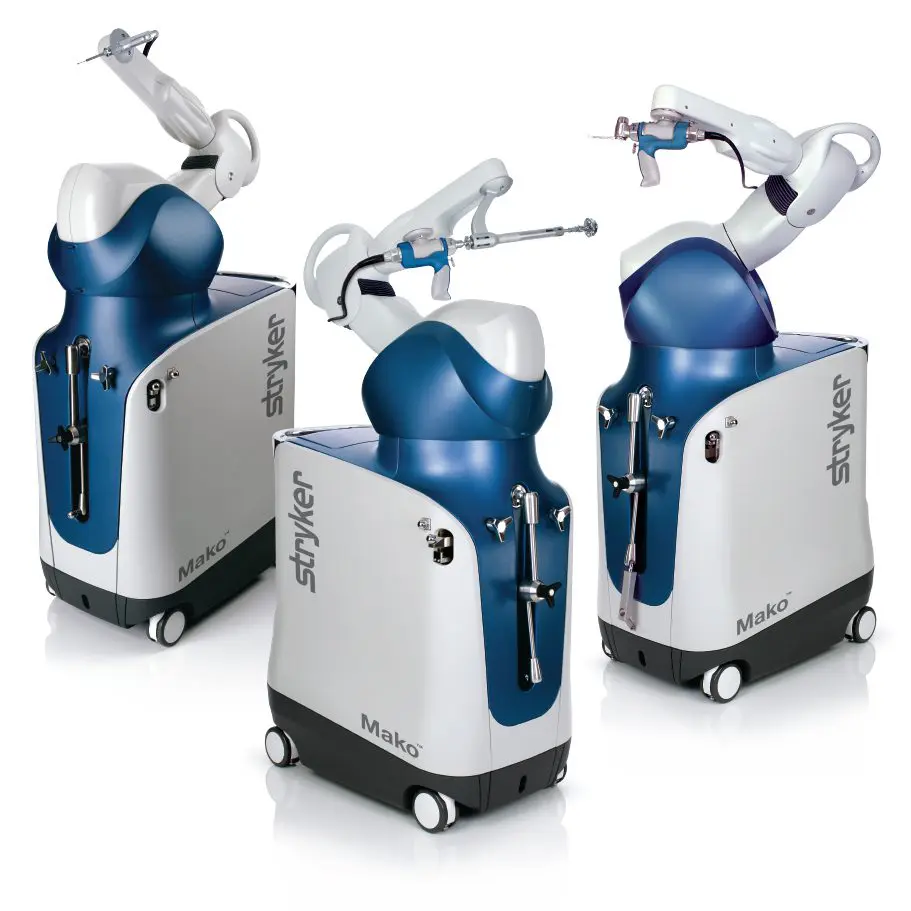
With the support of robotic arms, surgeons can operate with greater precision and better protect the surrounding tissue. Compared to conventional surgical methods, robot-assisted procedures often result in less pain and therefore shorter healing times. This method increases patient safety.
Precise planning on the 3D model of your joint
Various robotic models are currently available for the implantation of joint prostheses and are also in use in Switzerland. The special feature of the MAKO system we use is that a computer tomography of the affected joint is carried out before each operation. A 3D model of your individual joint is created from these images. Using this model, we are able to plan the exact size and positioning of the prosthesis before the operation. The three-dimensional image provides us with far more information than an X-ray. This allows us to precisely analyze and correct misalignments and position the prosthesis in such a way that your natural anatomy is restored as accurately as possible. As a result, the joint feels more natural and the muscles can work more effectively.
Fine-tuning the planning during the operation
During the operation, further dynamic parameters can then be included in the planning. The joint is moved and the movement sequence is recorded using computer technology. The joint stability can be measured, as can the leg position or leg length. These parameters can be used to optimize the positioning of the prosthesis in the millimetre range before the final prosthesis is inserted or the final bone cuts are made. This allows optimized joint stability and natural joint movement to be achieved, as well as precise adjustment of the leg length and axis position.
Precise implementation of planning with robot technology
Once the final computer-aided planning has been completed and approved by the surgeon, the next step is precise implementation. The robot supports the surgeon in this process. It sets the correct sawing level and checks the cutter to ensure that there are no deviations. The surgeon cannot remove too much or too little bone. The haptic limits of the robot also prevent damage to the surrounding soft tissue. The precision has a deviation of less than 1 mm. This significantly reduces surgical errors, even among younger and less experienced surgeons, as we were able to show in our own study.
Thanks to the very detailed surgical planning before the procedure and the extremely standardized implementation with robotic support, we have been able to significantly reduce the procedure time in recent years. On average, the operation time of 55 minutes per procedure is significantly less than before the introduction of robotic technology in our clinic. This also contributes to a reduction in the risk of complications.
Scientifically proven faster rehabilitation and fewer revisions
Overall, robotic assistance during operations means greater effort and is also more expensive than conventional manual technology. These additional costs and the extra effort are only justified if there is also a clinical benefit for patients. After more than 10 years of clinical use of the MAKO system, there are already numerous studies that highlight the benefits of robot technology. We also have our own data from ongoing scientific follow-up examinations of our patients.
Partial knee prostheses
- Our own data shows a 75% reduction in complications since the introduction of robot technology
- This means a lower complication rate than total prostheses within the first 2 years
- Lowest re-operation rate for robot-assisted partial dentures in the Swiss Prosthesis Register after 5 years
- Improved prosthesis fit through image-guided planning compared to other technologies
- Less post-operative pain and faster rehabilitation in numerous studies
Total knee prostheses
- Reduction of the 5-year complication rate by around 30% since the introduction of robot technology
- Higher patient satisfaction after knee prosthesis through implementation of an individualized prosthesis position
- Less need for physiotherapy after the operation compared to before the robot was introduced
- Reduction in hospital stay by 1-2 days since the introduction of robot technology
Total hip prostheses
- Faster post-operative remobilization and reduction of hospital stay by 1-2 days
- Reduction of “outliers” during implant positioning and more precise leg length adjustment
- Reduced complication rate of around 30% since the introduction of robot technology in our department
- Gentler surgery and less blood loss
Despite the proven advantages, it should be noted that a perfectly functioning prosthesis that has been implanted without robotic support is always equivalent to a prosthesis that has been implanted perfectly with robotic support. The surgeon and his experience play a decisive role in both scenarios. An experienced surgeon can achieve the same results without a robot.
In our experience in a specialist practice for prosthetics, however, the use of technology helps with the standardization and reproducibility of the procedure and thus helps to achieve the effects mentioned. However, it is not so much the robot itself that is responsible for this, but rather the surgeon and his settings.